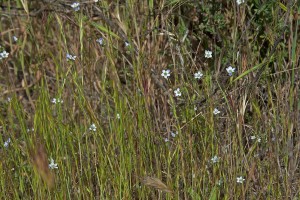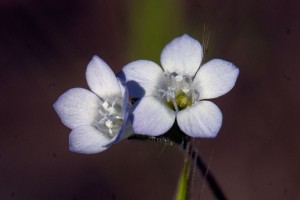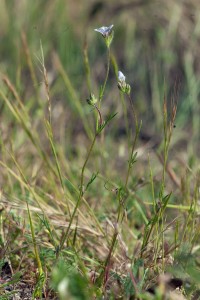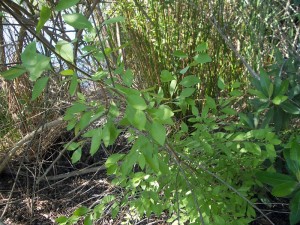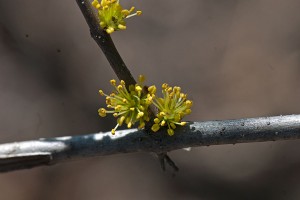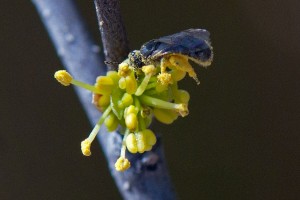Two new plants have recently been discovered at the BFS. Many thanks to Leroy Gross and Erika Gardner of the Rancho Santa Ana Botanic Garden for identifying the plants and making voucher specimens.
- Gilia angelensis
A patch of Gilia angelensis (Chaparral Gilia) is flowering in a grassy area along the path by the Foothill Blvd fence.
This dainty wildflower in the Phlox family (Polemoniaceae) has five-petaled pale lavender flowers with blue anthers.
The slender plants are about 6″ tall. The flowers only open in bright sunlight. When the flowers are closed – as on overcast mornings or late in the day – the plants are quite inconspicuous.
We’re not certain why we haven’t previously spotted these petite wildflowers, which are native to California and Baja California. Gibson and Prigge (2003) say that G. angelensis is “abundant in certain years and sparse and uncommon in others due to differences in rainfall patterns.” Also, as far as we know there is only one patch of these flowers. If you spot them in other locations, please tell the BFS Manager (jennifer_gee@cuc.claremont.edu).
To see all our photos of G. angelensis, click here.
- Forestiera pubescens
A lone shrub on the north shore of pHake Lake near the little island has puzzled us for some time. We now know it’s Forestiera pubescens, a member of the Olive family (Oleaceae), that’s native to the southwestern US (from Texas and Oklahoma to California) and Mexico. F. pubescens has a plethora of common names – Stretchberry, Desert Olive, Tanglewood, Devil’s Elbow, Spring Goldenglow, Spring Herald, Texas Forsythia, and others.
The stems of F. pubescens are opposite and come off the branch at nearly right angles, apparently leading to the names Elbow-Bush and Devil’s Elbow.
F. pubescens blooms before the leaves emerge, so in late winter or early spring, the bare branches “glow” with many yellow or yellow-green flowers (hence “Spring Herald” and “Spring Goldenglow”). F. pubescens is dioecious, meaning that male and female flowers occur on different individuals, and the plant at the BFS is a male.
The flowers are an early source of nectar and pollen for bees and other insects, and they seemed to be enjoyed by this little native bee:
Female plants produce fleshy, blue-black fruits that are an important food source for birds and small mammals; however, since our lone plant is male, we won’t be seeing any fruits at the BFS.
Although F. pubescens is native to this general area, it’s not normally found in the plant communities of the BFS. It could possibly have been brought here by a bird.
To see all our photos of F. pubescens, click here.
- Sources:
- Bryant, P. 2008. Los Angeles Gilia, Gilia angelensis. Vascular Plants of Orange County, California. University of California, Irvine. http://nathistoc.bio.uci.edu/plants/Polemoniaceae/Gilia%20angelensis.htm
- Steele, R. 2005. Oleaceae: Forestiera pubescens. Image Archive of Central Texas Plants. BIO 406D (Native Plants of Central Texas), University of Texas at Austin. http://www.sbs.utexas.edu/bio406d/images/pics/ole/forestiera_pubescens.htm
- Texas Agriculture Program. 2002. Texas Elbow-Bush. Texas Native Shrubs. Department of Horicultural Science. Texas A&M University. http://aggie-horticulture.tamu.edu/ornamentals/nativeshrubs/forestierapubescen.htm
- TWC Staff. 2011. Forestiera pubescens Nutt. Native Plants Database. Lady Bird Johnson Wildflower Center, University of Texas at Austin. http://www.wildflower.org/plants/result.php?id_plant=FOPU2
